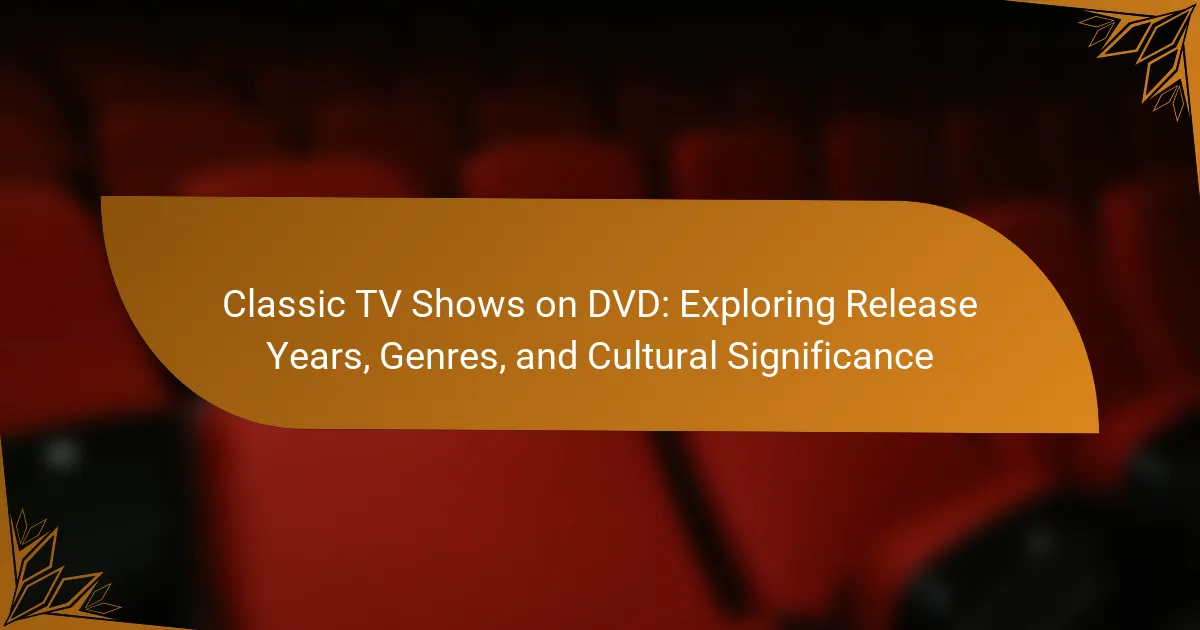Classic TV shows on DVD are collections of iconic television series released in digital format for home viewing, showcasing memorable characters and storylines from earlier decades. This article explores notable series such as “I Love Lucy,” “The Twilight Zone,” and “M*A*S*H,” highlighting their release years, diverse genres—including comedy, drama, science fiction, and westerns—and their cultural significance. Additionally, it discusses how viewers can enhance their experience through thoughtful engagement with the content, including the use of bonus features and community discussions. The preservation and accessibility of these classic shows through DVD collections contribute to the appreciation of television history and its impact on culture.

What are Classic TV Shows on DVD?
Classic TV shows on DVD are collections of television series that have been released in digital format for home viewing. These shows typically originate from earlier decades, often featuring iconic characters and memorable storylines. DVDs allow fans to enjoy episodes in high quality and often include bonus content such as interviews and behind-the-scenes features. Classic shows include titles like “I Love Lucy,” “The Twilight Zone,” and “M*A*S*H.” The release of these DVDs has made it easier to access and preserve television history. Many of these collections are curated to highlight significant cultural moments and trends from their respective eras.
How did classic TV shows transition to DVD format?
Classic TV shows transitioned to DVD format through a systematic process initiated in the late 1990s. This transition began as technology advanced and consumer demand for home media increased. DVD format offered better video and audio quality compared to VHS tapes. Additionally, DVDs allowed for bonus content, such as behind-the-scenes footage and interviews. Major studios recognized the potential for revenue from classic series. They began remastering and packaging these shows for DVD release. The first significant releases included iconic series like “I Love Lucy” and “The Twilight Zone.” This shift helped preserve classic television history for new audiences. By the early 2000s, many classic shows had been successfully transitioned to DVD.
What technological advancements facilitated this transition?
The transition to classic TV shows on DVD was facilitated by advancements in digital storage technology. Improved compression algorithms allowed for more efficient storage of video content. The development of DVD technology enabled higher quality video and audio compared to VHS. Enhanced authoring software made it easier to create special features and menus for DVD releases. The rise of home computer technology allowed consumers to access and play DVDs more easily. Increased bandwidth and internet speeds also supported the distribution of content digitally. These advancements collectively transformed how classic TV shows were packaged and consumed.
How does the DVD format enhance the viewing experience?
The DVD format enhances the viewing experience through superior video and audio quality. DVDs provide digital video that is clearer than VHS tapes. The standard resolution for DVDs is 480p, offering enhanced clarity. Additionally, DVDs support surround sound formats like Dolby Digital. This improves audio immersion during playback. The format also allows for interactive menus and bonus features. Viewers can access behind-the-scenes content and commentary. Furthermore, DVDs offer chapter selection for easy navigation. This convenience enhances the overall enjoyment of classic TV shows.
Why are classic TV shows significant in television history?
Classic TV shows are significant in television history due to their lasting cultural impact and influence on modern programming. They established foundational genres and storytelling techniques that continue to shape contemporary television. Shows like “I Love Lucy” pioneered the sitcom format, introducing multi-camera setups and live audiences. “The Twilight Zone” revolutionized anthology storytelling and explored complex social issues. Classic shows often reflect societal values and challenges of their time, providing historical context. Their popularity led to the creation of fan bases and merchandise, influencing marketing strategies in the industry. Many classic shows have been preserved and remastered for modern audiences, ensuring their relevance. Their themes and characters have inspired countless remakes and adaptations, demonstrating their enduring legacy.
What cultural impact did these shows have during their original airing?
Classic TV shows had a significant cultural impact during their original airing. They shaped societal norms and influenced public discourse. Shows like “I Love Lucy” broke racial barriers and showcased mixed-race couples. “M*A*S*H” addressed the realities of war and mental health, sparking conversations on these topics. “The Mary Tyler Moore Show” empowered women, promoting gender equality in the workplace. These series reflected and challenged cultural attitudes of their time. Their popularity led to shifts in television programming and storytelling. They established a blueprint for future shows to address social issues. The legacy of these shows continues to resonate in contemporary media.
How do classic TV shows reflect the social issues of their time?
Classic TV shows reflect the social issues of their time by addressing contemporary themes and cultural norms. These shows often incorporate social commentary on topics like gender roles, race relations, and economic challenges. For instance, “All in the Family” tackled issues of racism and sexism in the 1970s. Similarly, “The Mary Tyler Moore Show” highlighted women’s empowerment and workplace equality during the feminist movement.
The portrayal of characters and their struggles mirrors the societal values and conflicts of the era. For example, “M*A*S*H” used humor to discuss the Vietnam War and its impact on American society. Research indicates that television often serves as a cultural mirror, reflecting public sentiment and sparking dialogue on pressing issues.
By presenting relatable stories, classic TV shows invite viewers to engage with and reflect on societal changes. This connection between entertainment and social context demonstrates the significant role of television in shaping and reflecting cultural narratives.

What genres are represented in classic TV shows on DVD?
Classic TV shows on DVD represent various genres. These genres include comedy, drama, science fiction, fantasy, and westerns. Each genre showcases unique storytelling styles and themes. For example, comedies often focus on humor and character interactions. Dramas typically explore complex narratives and emotional depth. Science fiction and fantasy introduce imaginative concepts and futuristic settings. Westerns often depict stories set in the American frontier. The diversity of genres reflects the broad appeal of classic television. This variety contributes to the cultural significance of these shows.
How do different genres shape the content of classic TV shows?
Different genres significantly shape the content of classic TV shows by influencing narrative structure, character development, and thematic elements. For instance, sitcoms often emphasize humor and relatable scenarios, leading to lighthearted storylines. Dramas typically focus on character arcs and emotional depth, resulting in more complex narratives.
Science fiction introduces speculative elements, which can challenge societal norms and explore futuristic themes. Horror genres create suspense and fear, shaping content to engage viewers through tension and unexpected twists.
Historical context also plays a role; genres often reflect the cultural and social issues of their time. For example, the rise of family-oriented sitcoms in the 1950s mirrored post-war societal values.
Overall, the genre of a classic TV show directly impacts its storytelling approach and audience engagement.
What are the most popular genres among classic TV shows?
The most popular genres among classic TV shows include sitcoms, dramas, and westerns. Sitcoms, such as “I Love Lucy” and “The Mary Tyler Moore Show,” often highlight humor and relatable situations. Dramas like “The Twilight Zone” and “Perry Mason” focus on storytelling and character development. Westerns, exemplified by “Gunsmoke” and “Bonanza,” showcase themes of adventure and morality. These genres have consistently attracted large audiences and remain influential in television history. Their enduring popularity is reflected in numerous DVD releases and ongoing cultural references.
How do genre conventions influence audience reception?
Genre conventions shape audience expectations and influence their reception of media. These conventions establish familiar patterns in storytelling, character development, and visual style. For example, a comedy typically features humor, light-hearted situations, and happy endings. In contrast, a drama may include serious themes, conflict, and emotional depth.
When audiences engage with a genre, they bring prior knowledge and experiences. This familiarity can enhance enjoyment and understanding. Research by the University of Southern California shows that viewers who recognize genre conventions are more likely to appreciate and connect with the content.
Conversely, deviations from established conventions can lead to confusion or disappointment. For instance, a horror film that lacks suspense may frustrate viewers expecting traditional scares. Overall, genre conventions play a crucial role in shaping how audiences interpret and respond to classic TV shows.
What role do classic TV shows play in modern entertainment?
Classic TV shows serve as foundational elements in modern entertainment. They influence contemporary storytelling and character development. Many current series draw inspiration from classic narratives and formats. For example, sitcoms today often mimic the structure of shows like “Friends” or “I Love Lucy.” Classic TV shows also provide a cultural touchstone for audiences. They evoke nostalgia and connect viewers across generations. Streaming platforms frequently feature these classics, expanding their reach. According to a 2021 Nielsen report, classic shows have significant viewership on streaming services. This demonstrates their ongoing relevance and impact on modern media consumption.
How are classic shows being reimagined or referenced in contemporary media?
Classic shows are being reimagined and referenced in contemporary media through remakes, reboots, and nostalgic references. Many networks are producing updated versions of popular series, appealing to both new audiences and original fans. For instance, “Fuller House” is a reboot of “Full House,” maintaining the original’s core themes while introducing new storylines. Additionally, shows like “The Conners” continue the legacy of “Roseanne,” adapting to current social issues. Nostalgic references are prevalent in various formats, including films and streaming series, which often pay homage to classic shows. This trend highlights the lasting impact of these original series on modern storytelling.
What is the significance of nostalgia in the popularity of classic TV shows?
Nostalgia significantly contributes to the popularity of classic TV shows. It evokes fond memories of past experiences for viewers. This emotional connection encourages audiences to revisit familiar content. Research shows that nostalgia can enhance mood and provide comfort. Classic TV shows often reflect simpler times, appealing to viewers seeking escape. The resurgence of these shows in streaming services confirms their enduring appeal. Studies indicate that nostalgia can also foster social connections among fans. The combination of emotional resonance and community engagement drives the continued interest in classic TV programming.

What are the release years of notable classic TV shows on DVD?
Notable classic TV shows were released on DVD in various years. “I Love Lucy” was released on DVD in 2007. “The Twilight Zone” DVD collection came out in 2002. “M*A*S*H” was made available on DVD starting in 2002. “The Andy Griffith Show” DVDs were released in 2007. “Cheers” was released on DVD in 2004. “Happy Days” DVDs were launched in 2004. “The X-Files” DVD collection began in 2001. Each of these shows has a significant cultural impact and continues to be celebrated through their DVD releases.
How do release years correlate with the cultural significance of these shows?
Release years significantly correlate with the cultural significance of classic TV shows. The time period in which a show is released often reflects societal values, norms, and issues. For example, shows from the 1960s, like “Star Trek,” tackled themes of diversity and inclusion during a time of social upheaval. Similarly, the 1980s saw the rise of sitcoms like “The Cosby Show,” which addressed family dynamics and race in America. These shows became cultural touchstones that influenced public discourse. Additionally, the release year impacts the show’s technological presentation and storytelling style, which can resonate differently with audiences over time. Historical context shapes the relevance and reception of these programs, making their release years critical for understanding their lasting impact.
What trends can be observed in the release years of classic TV shows on DVD?
Classic TV shows on DVD have seen notable trends in their release years. Many classic series were released on DVD during the early 2000s. This period marked a surge in interest for nostalgia-driven content. The trend continued with significant releases peaking around 2005 to 2010. Popular series from the 1970s and 1980s were prioritized during this time. More recent releases have focused on shows from the 1990s and early 2000s. This reflects changing viewer demographics and nostalgia cycles. Additionally, some shows have been re-released in special editions years after their initial DVD launches. Overall, the release years show a pattern of nostalgia-driven demand, often coinciding with anniversaries of the original broadcasts.
How do different release years affect the availability of shows on DVD?
Different release years significantly impact the availability of shows on DVD. Shows released in recent years often have more accessible DVD releases due to current market demand. Conversely, older shows may have limited DVD availability, especially if they were not initially popular. The number of seasons produced also influences availability; shows with fewer seasons may be released on DVD more readily. Additionally, licensing agreements and rights can affect the release of older shows. For example, shows from the 1980s may face challenges in securing distribution rights, leading to fewer DVD options. Historical trends show that shows with cult followings are more likely to receive DVD releases, regardless of their original air date. Overall, the release year plays a crucial role in determining how readily a show is available on DVD.
What are some key milestones in the release of classic TV shows on DVD?
The release of classic TV shows on DVD has several key milestones. The first major milestone occurred in 1997 with the release of “The X-Files” Season 1 on DVD. This marked the beginning of a new era for home entertainment. In 2001, “I Love Lucy” was released on DVD, showcasing the popularity of classic sitcoms in the format. The release of “The Twilight Zone” in 2002 further solidified the trend of classic shows being made available to audiences. By 2004, “The Simpsons” began releasing complete seasons, attracting a massive fan base. In 2008, “The Golden Girls” was released, appealing to nostalgic viewers. The release of “Friends” on DVD in 2005 also became a significant cultural phenomenon. These milestones highlight the growing demand for classic television content in DVD format.
What were the first classic TV shows released on DVD?
The first classic TV shows released on DVD were “The X-Files” and “Star Trek: The Next Generation.” “The X-Files” DVD set was released in 1998. “Star Trek: The Next Generation” followed shortly after in 1999. These releases marked significant milestones in the home video market. They introduced viewers to the concept of owning complete seasons of their favorite shows. The popularity of these sets paved the way for future classic TV show releases on DVD.
How have packaging and bonus features evolved over the years?
Packaging and bonus features for classic TV shows on DVD have significantly evolved over the years. Initially, packaging was basic, often consisting of simple plastic cases with minimal artwork. As demand grew, companies began to design more visually appealing boxes with unique artwork and collectible elements.
Bonus features have also expanded. Early releases offered little more than the episodes themselves. Over time, studios started including behind-the-scenes footage, commentaries, and interviews with cast and crew.
In recent years, the trend has shifted towards including interactive content and digital access codes. These enhancements cater to a more tech-savvy audience.
This evolution reflects changing consumer expectations for value and engagement in home media. The rise of collector’s editions showcases this shift, often featuring extensive bonus content and premium packaging.

How can viewers best appreciate classic TV shows on DVD?
Viewers can best appreciate classic TV shows on DVD by engaging with the content thoughtfully. Watching episodes in order preserves the narrative flow. Utilizing bonus features enhances understanding of the show’s context. Exploring behind-the-scenes documentaries provides insights into production choices. Discussing episodes with friends or online communities enriches the viewing experience. Taking notes on character development and themes aids retention. Researching the cultural impact of the shows adds depth to appreciation. Collecting limited edition releases can also enhance the experience through nostalgia and value.
What tips can enhance the viewing experience of classic TV shows?
To enhance the viewing experience of classic TV shows, consider the following tips. First, watch the shows in their original format to appreciate the intended presentation. This often includes the original aspect ratio and audio quality. Second, use high-definition versions if available. Remastered versions can improve visual clarity and sound. Third, engage with supplementary materials. Many DVDs include behind-the-scenes features, commentaries, and interviews that provide context. Fourth, create a comfortable viewing environment. Good lighting and seating can improve focus and enjoyment. Fifth, watch with others to share insights and reactions. Discussing episodes can deepen understanding and appreciation. Lastly, research the historical context of the shows. Knowing the cultural significance enhances the viewing experience. These tips can transform how classic TV shows are enjoyed, making them more engaging and meaningful.
How can viewers engage with the cultural context of the shows?
Viewers can engage with the cultural context of classic TV shows by analyzing their themes and historical settings. Understanding the social issues portrayed in these shows provides insight into the era they represent. For example, “All in the Family” addressed racial and gender issues prevalent in the 1970s. Viewers can also explore behind-the-scenes documentaries or commentary tracks included in DVD releases. These materials often provide context about the creators’ intentions and societal influences. Additionally, participating in discussions or forums dedicated to classic TV shows can enhance understanding of their cultural significance. Engaging with academic analyses or articles about these shows can further deepen appreciation for their impact on society.
What are some recommended viewing practices for classic TV shows?
Recommended viewing practices for classic TV shows include watching in chronological order. This approach helps viewers understand character development and plot progression. Another practice is to watch with subtitles. Subtitles enhance comprehension of dialogue, especially in older shows with distinct accents. Engaging with companion materials enriches the experience. These materials may include behind-the-scenes documentaries or interviews with cast members. Joining discussion groups or online forums can also deepen appreciation. Sharing insights with others allows for diverse perspectives on themes and cultural impact. Lastly, taking breaks between episodes can prevent viewer fatigue. This practice allows for reflection on the content and its historical context.
Classic TV shows on DVD are collections of iconic television series released for home viewing, preserving significant cultural moments from earlier decades. The article explores the transition of these shows to DVD format, highlighting technological advancements that improved viewing quality and accessibility. It discusses the genres represented, their cultural impact during original airings, and how they reflect societal issues of their time. Additionally, it examines release years, key milestones, and viewing practices that enhance appreciation of these classic programs, emphasizing their ongoing relevance in modern entertainment.


